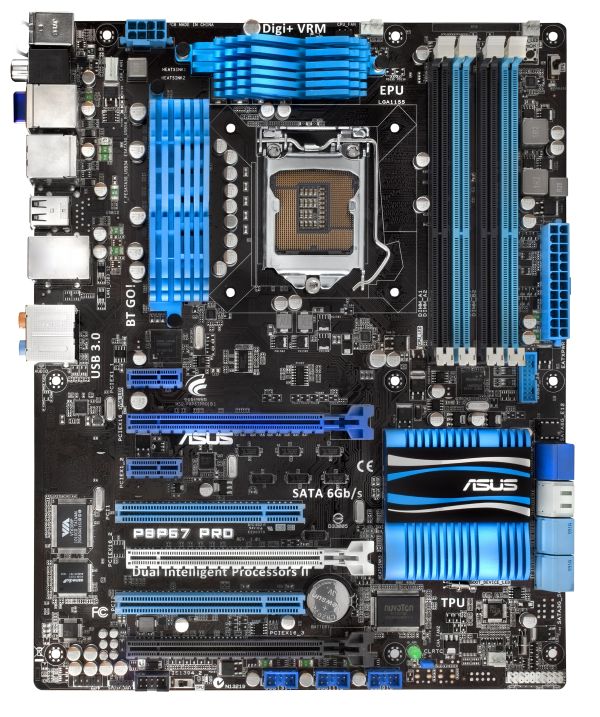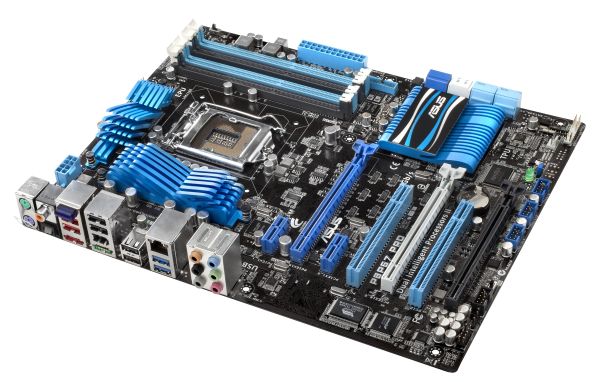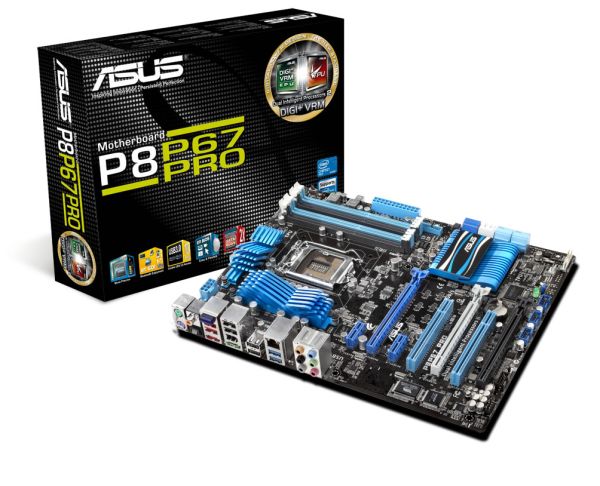The Battle of the P67 Boards - ASUS vs. Gigabyte at $190
by Ian Cutress on January 20, 2011 4:15 PM EST- Posted in
- Motherboards
- Gigabyte
- Asus
- P67
The ASUS P8P67 Pro fits near the beginning of the line-up in the ASUS launch, which in terms of ATX sized boards include the P8P67, the P8P67 Pro, the P8P67 Evo, the P8P67 Deluxe, the Sabertooth P67, the P8P67 WS SuperComputer and the top end Maximus IV Extreme. Therefore, with that in mind, we would expect to be looking at something above the base – slightly more (or better) features than the cheap boards available, enough to warrant the price difference. An overview of the P8P67 series is below:
| P8P67 Series | ||||||
| P8P67 LE | P8P67 | P8P67 PRO | P8P67 EVO | P8P67 Deluxe | ||
| Price | $140 | $160 | $190 | $210 | $235 | |
|
SATA 6 Gb/s SATA 3 Gb/s eSATA |
3 4 1 |
4 4 1 (bracket) |
4 4 2 |
4 4 2 |
4 4 2 |
|
|
CrossFireX SLI |
Yes No |
Yes No |
Yes Yes |
Yes Yes |
Yes Yes |
|
|
USB 3.0 USB 2.0 |
2 14 |
4 (2 via header) 12 |
||||
| LAN | 1 | 1 | 1 | 2 | 2 | |
| Bluetooth | No | Yes | Yes | Yes | Yes | |
Visual Inspection
ASUS have gone with the blue/white/black livery for the Pro board, with a 12+2 digital VRM design covered by slanted blue heat sinks. The socket itself is relatively clear, easily allowing large 1155/1156 CPU coolers to be fitted (remember, 1155 mounting holes are the same as 1156). The CPU fan header is located at roughly one o’clock from the socket itself, with a chassis header to the right of the DIMM slots, presumably for HDD bay type fans.
Next to this header are the EPU switch and the MemOK buttons. The EPU switch enables Energy Processing Unit, which is geared towards saving energy – this encompasses power gating certain features that are never used/used rarely, and declocking when less compute is required. The MemOK button is a physical override for overclocked memory – by holding it down until the red light comes on, at next boot, the UEFI will override the memory settings to something more suitable.
The SATA connectors come in blue (SATA 3 Gb/s), white/grey (SATA 6 Gb/s provided by the chipset) and navy blue (SATA 6 Gb/s provided by a Marvell controller). There is a USB 3.0 header also here, near the DIMM slots. These are all next to the ASUS logo and chipset cooler, which underneath have another chassis header and a green power light. This board is lacking both a debug LED and power/reset buttons on the main board, much to our disappointment.
The PCI slots are well laid out, with a PCIe 1x at the top and enough space between the first two PCIe x16 for a PCI card, meaning that at least one is available if all three PCIe x16 are occupied with dual slot cards. The black PCIe x16 slot is wired up as an x4 slot (as it shares bandwidth with the x1 slots, two USB 3.0 ports and the eSATA ports), and with a dual slot card in there, will cover most of the board USB headers.
The TPU switch is underneath the PCI slots, and performs the same function as the TurboV EVO software in the OS to optimise the system for a decent and stable overclock.
The back panel is standard, with dual PS/2 connectors, SPDIF outputs, USB 2.0 slots, USB 3.0 slots, Firewire, eSATA, audio and Ethernet. The blue module three from the left is the ASUS Bluetooth module, designed to communicate with Bluetooth devices to enhance overclocking or utilise music management. The gigabit Ethernet is handily powered by an Intel chip.














137 Comments
View All Comments
James5mith - Friday, January 21, 2011 - link
One big giant reason to use the Asus board? Intel® 82579 Gigabit EthernetAn Intel PHYS on an Intel board means one less PCIe lane taken up by the NIC. Not to mention, it's Intel not Realtek.
Mumrik - Friday, January 21, 2011 - link
‘if I’d rather take a $150 board rather than a $190 board, why are there $300 boards available?’No, the question is why you don't focus more on reviewing the lower end boards. Motherboards have become too expensive, especially when you consider how much is being moved onto the CPU. These were Asus' and Gigabyte's midrange boards. I'd love to hear more about the two below them in the two companies' lineups. Let's hear if there's a reason not to pick the 130-150 options.
erple2 - Friday, January 21, 2011 - link
I think the question is still extremely valid - if the 150 dollar board gives you all of the performance of the 190 dollar boards, where does that leave the 300 dollar boards?You also bring up another good question - what can the 150 dollar board buy you that the 100 board doesn't have?
My assumption is that there are various features that simply don't exist on the sub-100 dollar boards.
BTW, I'm not sure that motherboards are really all that expensive. At least, not beyond "standard inflation". The same level of features (of the day) cost about the same amount as they do today, I think.
7Enigma - Tuesday, January 25, 2011 - link
If this is standard inflation we are in for a world of hurt....sweetspot - Friday, January 21, 2011 - link
Just me but id prefer 70fps in my games if sound quality was excellent vs 75-80 FPS and unusable sound mobo parts. And or have to pay additional for add on pci sound card cash which defeats the savings shown using the asrock 150 mobo yet sounds bad so pay 50-70 more for add on card, vs the 2 190 boards sounds are good, So the value set he describes in this review of the 40 dollar cheaper board is totaly stupid since he failed to show the boards major components correctly ( Yes sound on a mobo is consider a major component piece of the many).Sure reader can go elsewhere to get the info but the point of the review sites is to cover basic parts so people dont have to web hop all day for those details.
faxon - Friday, January 21, 2011 - link
I wanna see a review of these vs the P67-GD65 from MSI. its the cheapest 8 SATA port board on the market and other sites have been saying it looks pretty good, wondering what you guys think before i buy it thoughHauntFox - Friday, January 21, 2011 - link
I just built a new system with this Asus board, it is quite nice, except I do not like the sata ports that point to the front. I barely have enough room to plug a sata cable into them with my case because the drive cage is in the way.RussianSensation - Friday, January 21, 2011 - link
Legit Reviews did a comparison, which can be found here: http://www.legitreviews.com/article/1500/1/1) Realtek vs. Intel - Besides a 3% lower CPU performance, the throughput is hardly any better wtih Intel. Also, unless you are networking multiple computers, we aren't going to be hitting 900+MB/sec in Internet speed.
2) 16x/4x vs. 8x/8x in CrossFire - Since P67 chipset runs PCIe 2.0 at full speed unlike P55 chipset, the PCIe 4x slot off the P67 chipset actually has 2x the PCIe bandwidth compared to P55 16x/4x boards. Overall, when testing with HD6950s in CF, the performance difference is almost nonexistent.
So overall, the stock P8P67 board looks like the one to get for those running single-GPUs.
Exodite - Monday, January 24, 2011 - link
I'd get the ASUS just for the Intel LAN solution TBH.I can't say whether it's hard- or software, or a combination of the two, but Realtek ended up as a real step down from the Marvell solution in my previous motherboard and I'd avoid it in the future if I can.
Most notably I went from a 30-40ms latency in WoW to 100-120ms with the Realtek. This was only recently rectified, well mostly rectified, with a driver update.
So for me personally i'd definitely be worth it. It's nice to see a review that tests the LAN solutions but frankly just testing throughput and CPU usage is rather disingenuous as latency and jitter probably play a larger role in most network-related usage.
fixxxer0 - Saturday, January 22, 2011 - link
how come there are no tests showing the SATA 6.0 speed comparisons?